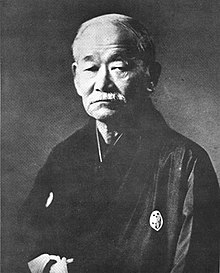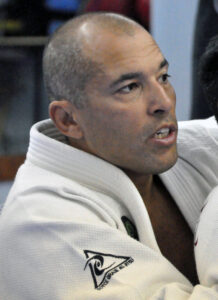At first sight, Brazilian jiu jitsu (BJJ) and Judo may look the same due to similar uniforms and techniques fighters are performing. But watch just a single match from both of these arts, and you can easily see how much they differ in a lot of aspects.
The biggest difference is that BJJ puts much more emphasis on ground fighting than judo which, on the other side, is more focused on throws. So in some way, BJJ is more versatile when it comes to positions on the ground, chokes, and joint locks. But Judo is much better in the standup aspect when it comes to powerful throws, sweeps, or trips.
Here are the other key differences between judo and jiu jitsu you should know about.
History and place of origins Judo VS Jiu Jitsu
Judo

Founded by Kano Jigoro in 1882, Judo is a fighting style that has origins in Japanese jujutsu. Jigoro, who was a jujutsu student, moved away to create his own fighting style called Judo. He used jujutsu as a base to create a style that puts a lot of emphasis on throws as well as ground fighting.
In the 1800s, the popularity of jujutsu began to fade mainly because it was too brutal. That’s why Jigoro designed judo to be very safe to train, good for your health, and does not include any weapons. This made judo very popular all across Japan in a short time span, and in other parts of the world as well.
In modern times, Judo is among the most popular fighting styles for both self-defense and as a sport. It has been a part of the Olympic Games since 1964 for men, and the women judokas came in 1992.
Jiu jitsu

BJJ started to come up in the 1920s in Brazil when famous Judoka, Mitsuyo Maeda, came to Brazil to teach Kodokan Judo. Some of his very first students were brothers Carlos and Helio Gracie. These two later used judo as a base to found their own fighting style. In some way, they did the same thing Jigoro did with Judo.
They named their new art “Gracie BJJ”, and this name is still in use today to some extent. The main goal of the art is to allow a small person to beat a much taller, heavier, and stronger opponent. The focus is on using leverage rather than sheer power to throw the opponent off balance. But unlike in judo, the focus is on ground fighting techniques like chokes and joint locks.
Right away, BJJ became very popular all over Brazil due to Gracie’s wins in Vale Tudo matches. Vale Tudo resembles modern MMA fighting and BJJ was by far the best fighting style at the time. In most matches, they would beat fighters from other arts like Luta Livre.
In the early 90s, Royce Gracie made BJJ even more popular by taking part in the early UFC events. He went on to beat fighters from other arts, and who were often much bigger than him using only BJJ skills.
Emphasis and tactics Judo VS Jiu Jitsu
Judo
Judo is a grappling art that includes both standup and ground fighting elements. It teaches you how to use various throws and trips to throw the opponent to the ground.
Once there, judokas can use pins, chokes, and joint locks to subdue the opponent. On paper, judo looks like an all-around grappling art that covers all the elements, and that is true to some extent.
But in reality, Judo focuses more on throws rather than fighting on the ground. Students spend more time learning trips and throws than how to place submissions. It’s all about getting a strong grip and using the opponent’s weight against them to take them down.
But why judo focuses so much on throws? This is because throws play a key role in judo competition where a single throw can win you a match. Judokas get only around the 30s to work on the ground, which is often not enough to pin or submit the opponent.
Jiu jitsu
Unlike in Judo, the emphasis of BJJ is on ground fighting and using various chokes and joint locks to finish the opponent. You see, each BJJ match starts on the feet where fighters must use Judo throws to take the opponent down. But the BJJ match really starts to play out once the fight hits the ground and fighters start battling for a position.
In BJJ training, students spend most of the time learning how to fight on the ground. In most schools, you will first learn the positions and submission on the ground before moving to throws and trips. This varies between schools but most of them prefer this approach since it is much safer.
Ground fighting in judo looks very basic compared with the one in BJJ which is far more versatile. It teaches you all types of positions, escapes, sweeps, chokes, locks, and many other techniques you won’t learn in judo.
Rules of competition Judo VS Jiu Jitsu
Judo
Judo is very popular as a sport and it has been a part of the Olympics since 1964. Judokas compete in the open mat and each match starts from a standing position. The matches last 4 minutes, and there are three ways you can win a match:
- Score a full point “Ippon“
- Score two Waza-Ari (half points)
- Accumulate more points than the opponent
If both judoka have the same amount of points when the time expires then they proceed to the Golden Score contest which lasts 3 minutes. Sounds a bit confusing, right? Here is how it works in practice.
The main goal in judo competition is to take the opponent down to the ground using throws or trips. For this, judokas will get one full point, or “Ippon”, which is enough to win a match. Or judoka can score a less powerful throw to get a Waza-Ari which is a half-point. If the time expires, the judoka with the most Waza-Ari (half-points) wins a match.
Scoring one Ippon is enough to win a match in Judo, but trust us, this is much harder than it sounds. The three ways they can get ippon is to take the opponent down using powerful throw, hold them down for the 20s, or submit using locks and chokes.
Jiu Jitsu
The rules in BJJ differ a lot from the ones in Judo. The main goal is to submit the opponent using chokes or joint locks. The competition also involves a scoring system, so fighters can also win via decision. Yet, it’s important to note that the length of the match and even the rules vary between the organizations.
BJJ matches last from 4 to 10 minutes depending on the belt rank of the fighters. Fighters compete in the open mat and each bout begins in a standing position the same as the ones in Judo. But the scoring is much different, here is how it works.
- Throws/Trips, sweeps, and knee mount position are awarded 2 points.
- Passing the opponent’s guard gets you 3 points.
- Securing a back mount or a full mount position will score you 4 points.
Uniforms Judo VS Jiu Jitsu
Judo
While training and competing, judokas must wear a uniform called “judogi”. It looks very similar to uniforms in other arts like karate and BJJ. Judogi has three main parts made out of thick cotton:
- A heavy jacket (uwagi)
- Pants (shitabaki or zubon)
- Belt around the waist (obi)
At first, it may look thicker than a BJJ gi, but it is actually lighter and longer. This makes it a lot easier for judoka to get a hold of the opponent’s sleeves and execute various throws. The design of judogi is very simple as they come only in white and blue color.
Jiu Jitsu
Like in Judo, BJJ fighters must wear a uniform called “Gi (clothes)” in training and while competing. The only exception is the “no-gi” form of BJJ in which the uniform is not mandatory. A Gi uniform is made out of cotton and it includes:
- heavy jacket
- pants
- belt rank
However, BJJ gi is heavier and has shorter sleeves and pants than judogi. It also comes in different colors like white, blue, or black, and fighters can wear team or sponsor patches on it.
